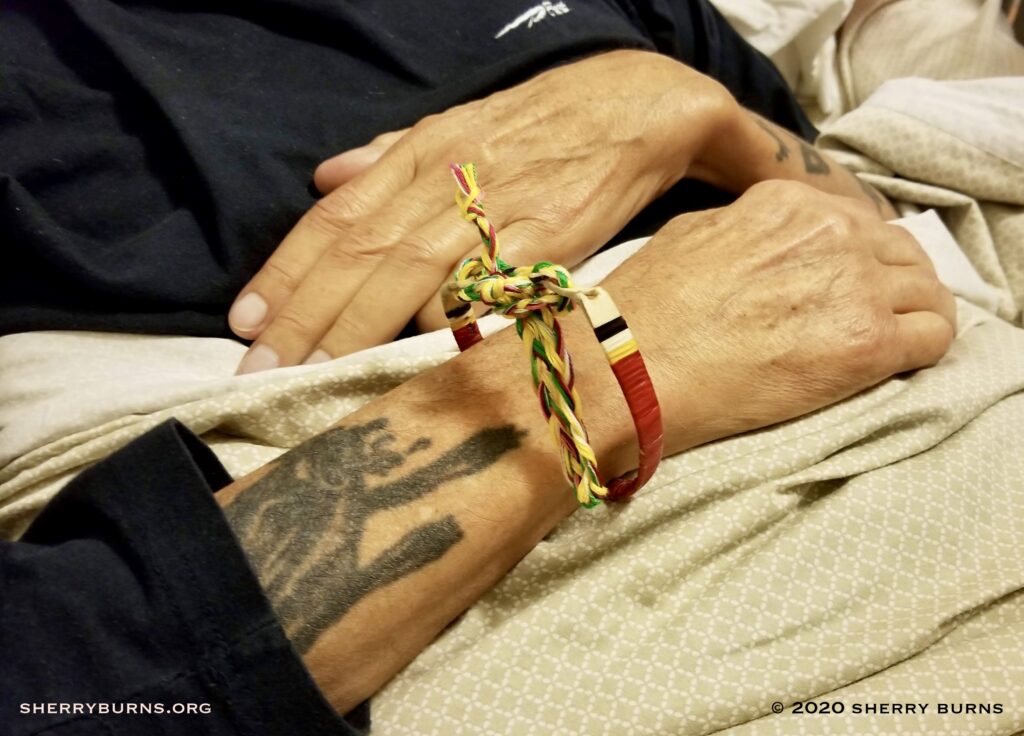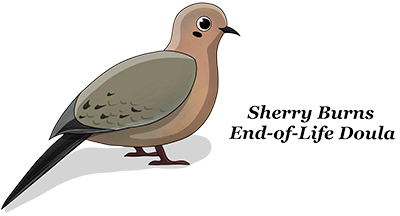When I was born, my paternal step-grandfather had died many years before. Due to the wrenching separation that can happen to families during war, we assumed my maternal grandparents were deceased. These grandparents were mysterious and bigger than life to me, and yet there was always an undertone of tragedy and loss. As a child, my family’s demographics comprised many senior citizens–from aunts and uncles, great aunts and great uncles, and one elderly grandmother. For this reason, it seemed like the phone rang often with news of another death. I remember going to so many funerals scattered around small towns in southern Kansas.
***
Now, as an adult, my encounters with death have come much closer to home. My adoptive-father, who had raised me as his own, died of colon cancer when I was 53. My son was 15, so still young and impressionable enough that my husband and I hovered around him, talking and watching and gauging how he handled this event. My father’s illness was my first experience with hospice and sitting vigil for my nuclear family. The ease and compassion with which the social workers, nurses, physicians, and volunteers moved about us provided comfort and a sense of security in that it felt the professionals were in control even as my mother and I fell apart.
One of the hardest tasks I had to undertake was calling the manufacturer of my father’s internal defibrillator to have their technician come turn it off. The hospice doctor had described an unpleasant scene if my father’s heart stopped but his defibrillator continued to go off, motivating me to make the urgent call. Standing around my father’s bed as the tech switched the device off was surreal and profound.
When my father weakened to the point that my mother couldn’t physically provide care, we admitted him to inpatient hospice. On arrival, as my mother and I discussed plans for the night, a nurse told us we had time. She assured us we needed to go home and get a good night’s rest in our own beds. She assured us she would tell us when it was time. Fourteen days later she did just that. A lot of family was crowded into my father’s room. We were reminiscing, drinking wine, and actually having a pleasant visit when the nurse pulled me aside. “It’s time. Tonight is the night for you to stay.” Her words pulled me back from the impromptu family reunion to reality. My mother and I caught moments of sleep off and on during the night as we watched my father, held his hand, talked to him. He transitioned peacefully the next morning.
***
Six years after my adoptive-father died, my mother was diagnosed with multiple myeloma. She had been struggling with a number of health challenges for a few years, which had resulted in her relinquishing her driver’s license, selling her home, and moving into assisted living. Once she understood this specific diagnosis, she had had enough and wanted to go. She assured me she wasn’t afraid of dying. She asked her gerontologist and later her hospice doctor if there wasn’t something they could do to hasten the end of her suffering. In the state of Kansas, Medical Assistance in Dying (MAID) is not legal.
She suffered with a great deal of pain in her last days and weeks. She was admitted to inpatient hospice for pain management, but that quickly changed to end-of-life care.
The relationship between my mother and me had always been challenging, and this period was no different. The days were filled with misunderstandings and frustration between us. I tried to say all those things the chaplains and social workers tell you to say — I forgive you…Please forgive me…I love you. I said them hoping they would set her free to move on, but they didn’t ring true.
My mom died late in the evening with her brother, sister-in-law, nieces and me surrounding her bed. I felt my father’s presence as he swooped in to take her. I stayed with her as the nursing assistants bathed her and got her ready. My husband and I sat with her until the funeral home transport driver arrived in the wee hours. We walked with her through the quiet halls of hospice house to the back door–a humble, peaceful procession.
With my mother’s death, I took a step further into my journey into death care by attending her cremation. I did not arrange to see her beforehand; I just wanted to be present. The funeral home had a small window in a back hallway that looked into the cremation room. My mother’s body was brought in and they gestured to my husband and me that her name was written on the cardboard box. I really wasn’t concerned about confirming her identity, but the funeral home seemed to want that verification. We watched as they slid the box into the retort and pressed the Ignite button. The retort operator looked at me to ensure I understood. My husband and I sat for a while, pondering what was happening.
***
On May 5, 2015, I made contact online with the man I had been looking for my entire adult life — my birth father. Growing up, explanations of his identity and whereabouts were inconsistent, leaving me unsure if he was alive or dead, a nice or a mean person. The prevailing story was that he had died in a car accident a month before I was born.
Over the years I’d tried to learn his identity, but had no real leads. Around 2010 I completed a DNA test with 23andMe, on the long shot that I might find some clues. Years passed, and I felt even more defeated. But then in the spring of 2015 I was matched with a first cousin. I worked with a genetic genealogist who found my father with astounding quickness. He was alive and living in Seattle, Washington. We introduced ourselves to each other over Facebook Messenger. We met in September when my husband and I flew out to meet him.
Over the next two years, I made trips to Seattle and he came to visit me in Kansas City. We spent a grand total of 20 days together. Then in late November 2017 we learned he was seriously ill. Over the phone, I asked him if he didn’t want to undergo any tests or treatments. He replied “It’s just time to get this done.” I admired and respected him for the clarity with which he expressed his desires. But my heart broke at the thought that we would have no more time together. 20 days. That’s the number in our Akashic records. Apparently.
Richard was admitted to in-home hospice care. I flew to Seattle, letting my work know what was happening and that I didn’t know when I would be back. Thank God for wonderful, compassionate managers. I received so many phone calls, texts, and cards from people expressing their sadness. The same people who were over the moon along with me when I found Richard.
I arrived in Seattle late evening and was met at the door by my aunt who wanted to forewarn me that he had taken a turn for the worse during the afternoon. He was very agitated and anxious. He seemed happy to see me, though, when I walked in and we chatted. That evening would be the last time he really conversed or seemed to recognize people. To calm his agitation, the hospice nurses urged us to dispense his pain and anxiety meds on a very rigid schedule. Like I experienced with my adoptive-father and my mother, I was filled with doubt about the dosing. Couldn’t we give him a little less so he could be a more awake?
One evening, my father’s closest friends came to visit. He woke up enough to recognize them and reach out to them. His close friend Howard, brought him a Native American bracelet that he said was called a ticket to heaven. The bracelet was big, so we wove a delicate cord from multicolored sewing threads and tied it to Richard’s wrist.
During these days, someone was always with Richard. During the day we rotated in and out. At night a nurse stayed with him. We visited and even ate meals in the room with Richard. It was such a close time. When some family arrived from western Washington the atmosphere almost turned into a family reunion, which I think happens often in times like this. There was much reminiscing, wine, laughter, and for me, getting to know relatives I’d never met before. As it got late, the family moved to another room so Richard could rest comfortably. Around midnight the nurse came looking for me. I knew what had happened by the look on her face. My first reaction was horror at the thought that Richard had died alone. (At that time, I was training to volunteer for a No One Dies Alone program.) The nurse reminded me that she was with him. Everything suddenly seemed busy with the nurse calling hospice, the nurse manager arriving, people bustling about.
But when the nurse manager called the funeral home, I said no. I confess I didn’t ask the family how they felt about it, but I wanted him to stay home overnight. It was now something like 2:00 in the morning. Some family members were asleep. i didn’t want him whisked away into the darkness.
We opened all the windows and turned off the heat to keep his room cool. I assisted the nurses as they bathed him, changed the sheets, dressed him in comfortable clean clothes. He looked peaceful. The next morning, children in the family brought him drawings and flowers. We each took our own time to sit with him. And late in the afternoon, when we were ready, we called the funeral home.
I stayed with him as the funeral home staff got him ready. I helped however I could, which wasn’t much more than tucking in a sheet here or there. My aunt draped a New Mexico flag over him. At her request, we sang Somewhere Over the Rainbow as we escorted him out. I sang for as long as I could, but then the words just stopped coming. Grief seemed to bubble up and out of my aunt, and she sang with all her heart when none of the rest of us could.
My aunt and I went to the cremation; she remained in the viewing lobby while I went went in to the cremation room. I was able to see Richard one last time. I watched as they placed him in the retort and closed the door. The technician showed me a computer screen with a large red START button. She placed her hand on my shoulder and said “Take all the time you need.” I’d like to think that I prayed or did something spiritual and wise, but I think my mind and heart were scrambling. I know I told him goodbye and thank you for opening his heart to me when he learned he had a daughter. And I told him I loved him. I took the computer mouse, clicked the button, and heard the retort ignite.
The family was adamant about having a celebration rather than a morose funeral. We notified Richard’s friends. Copious quantities of champagne, wine, and Hornitos were obtained. Richard’s collection of colorful Hawaiian shirts and his hats were put on display. And, best of all, a taco truck was procured for the event. (My father was of Mexican ethnicity.)
In August 2019, the family gathered to scatter Richard’s ashes on his father’s grave in a tiny cemetery in New Mexico. We read poems, drank tequila and champagne, and remembered him.

